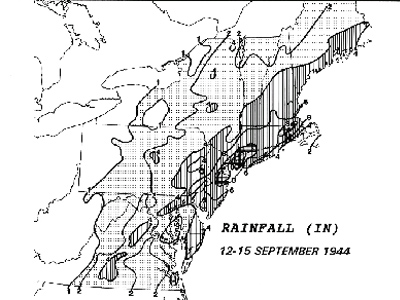The Great Atlantic Hurricane was an intense tropical cyclone that impacted the entire U.S. Atlantic seaboard in September 1944. Reconnaissance aircraft first discovered the fully developed hurricane on September 9, 1944, northeast of Puerto Rico. As the storm moved west-northwest, it steadily intensified. Further reconnaissance located the hurricane’s center off the northern Bahaman Islands on the evening of the 12 September. At this time, the Category 4 hurricane was moving forward at 32-48 km/h (20-30 mph) with top wind speeds of 240 km/h (150 mph). After taking a northward turn on 14 September, the center of the storm passed just east of Cape Hatteras, NC around 9:00AM. The hurricane then turned slightly to the northeast and accelerated to a forward speed of about 64 km/h (40 mph). At 10:00 PM on 14 September, the hurricane passed over eastern Long Island, NY as a Category 3 hurricane. The hurricane made landfall near Point Judith, RI an hour later and moved northeastward, passing just southeast of Boston, MA and out to sea at 1:00 am on 15 September. After weakening into a tropical storm, the system skimmed coastal Maine and moved into New Brunswick, Canada. Late on 15 September, the system became extratropical, and shortly after, merged with a larger system southeast of Greenland.
As the storm moved northward along 1440 km (900 mi) of the eastern Atlantic seaboard, from North Carolina up to Newfoundland, it caused widespread damage. The hurricane cost over $100 million (1944 USD, $1.2 Billion 2010 USD) in damage and killed 390 people. The storm wreaked havoc on World War II shipping lines, and five ships sunk during the storm, including two US coast guard cutters off of North Carolina (48 lives lost) and a US Navy destroyer off of Florida (248 lives lost). Mainland evacuations and careful warnings, however, allowed the death toll on land to be fairly low: 46 persons. During the storm, New York City saw sustained hurricane force winds of 130 km/h (81 mph) with gusts up to 158 km/h (99 mph). Damages consisted of power outages, some lasting 10 days, and downed trees throughout the city. In nearby Long Island, damages totaled $1 million (1944 USD) on the eastern half of the island alone. The beach eroded up to 6 m (20 ft) in some places, causing houses to be taken by the sea. In Connecticut, the most significant storm impact was the heavy, widespread rainfall. Totals of around 178 mm (7 in) were seen in the Hartford area, but the city of Bridgeport saw the greatest official total at 272.8 mm (10.7 in). Tobacco and fruit damage in Connecticut totaled to about $2 million (1944 USD) with similar overall damage costs occurring in Rhode Island. Greater than $5 million (1944 USD) in damage done on Cape Cod can be attributed to lost boats, as well as fallen trees and utility damage. Fast Facts:
Sources:
Sumner, H.C. “The North Atlantic Hurricane of September 8-16, 1944.” Monthly Weather Review Vol. 72, No. 9. 5 Dec. 1944. Web. http://docs.lib.noaa.gov/rescue/mwr/072/mwr-072-09-0187.pdf Great Atlantic Hurricane, September 1944 NHC Hurricane Preparedness Website NWS Eastern Region Headquarters “1944 Great Atlantic Hurricane.” Wikipedia. 2009. Web. Elliot, William and Charles Talcott. The Great Atlantic Hurricane. Blue Hill Meteorology Observatory, 1994. Barnes, Jay. North Carolina’s Hurricane History. Chapel Hill: UNC Press, 1998. Pp. 76-77. Dunn, Gordon E. and Banner I. Miller. Atlantic Hurricanes. Baton Rouge: Louisiana State University Press, 1964. Pp 156. The great Atlantic hurricane, September 8-16, 1944 : an historical & pictorial summary. Compiled and edited by William Elliott Minsinger, Charles Talcott Orloff Cobb, Hugh and David Roth. “Early Twentieth Century.” Virginia Hurricane History. 16 Jul. 2001. NOAA. Web. Weather Underground- The Lost Hurricane/Typhoon Hunters: In Memoriam |


